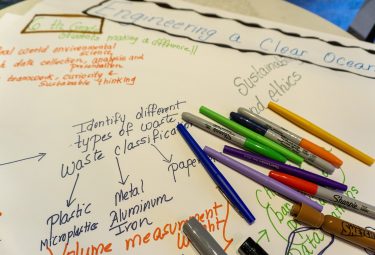Early bird rates are available for registration to the 2026 January ESIP Meeting. Register.
Data for Our Changing Earth: Realizing the Socioeconomic Value of Data
Author: Arika Virapongse, Middle Path EcoSolutions
Have you thought about how your work with data might be helping society improve? The theme for the 2018 summer ESIP conference, “Data for Our Changing Earth: Realizing the Socioeconomic Value of Data”, was focused on this very question. It is also reflective of the third goal of ESIP’s 2016-2020 Strategic Plan, which aims to:
“Promote techniques to articulate and measure the socioeconomic value and benefit of Earth science data, information, and applications”
If you attended the conference, you may have noted that the conference plenary and some of the sessions specifically addressed the theme. In this post, we highlight some of these presentations and sessions, as well as point out how ESIP’s theme complements the goals of its other organizational peers. The full list and descriptions of ESIP summer conference sessions and presentations can be found here.
To recognize outstanding individuals in the community, ESIP has several awards. Here is how this year’s summer awardees addressed the socioeconomic value of their work. Sara Lafia (University of California) received the Robert G. Raskin scholarship for her graduate research on developing linked data models and spatializations to enable the spatial discovery of researcher datasets and publications. Increasing the capabilities for data discovery is one of the best ways to enhance the potential societal benefits gained from data. The 2017 Charles S. Falkenberg Award was awarded to Hook Hua (NASA), who presented his perspectives about the growing importance of the cloud for Earth Science data systems. As data steadily increases in volume, the cloud can be key to both storing and processing data more efficiently, as well as making data more accessible. As an example of the importance of fast access to and analysis of up-to-date data, remote sensing data can make all the difference in disaster response, such as hurricanes, by helping people make better decisions about evacuation.
Most of the plenary talks touched upon some aspect of the socioeconomic value of data. As one example, Chris Guiterman from the Laboratory of Tree-Ring Research (University of Arizona) gave an insightful presentation about his close collaboration with the Navajo nation to understand and manage forest vulnerabilities to climate change. Such close links between research and community-based participation can lead to more actionable science and efficient natural resource management. A second example is Rowena Davis’s (Belmont Forum) presentation on “Transdisciplinary Research and the Belmont Forum e-Infrastructures and Data Management Project”, which described how transdisciplinary concepts are being used to guide their international data coordination approach. In the context of data and informatics, a transdisciplinary approach is particularly useful for developing, managing, and applying data toward seeking solutions for complex problems, co-generating innovative knowledge, and communicating across multiple audiences.
Two sessions addressed the role of place-based resilience use cases for the purposes of developing new data and informatics solutions to real-world challenges. The session on “Community Resilience: Demonstrating the Socioeconomic Value of Earth Science Data” brought in speakers that respectively introduced the challenges of standardizing terminology to help inform better management of watershed ecosystem services; and improving data literacy among the public to increase their ability to make decisions and take action toward urban resilience. A session on “How can CHRS RainSphere and USDA AgRisk Viewer teams promote the use of their tools for climate resilience” was organized by the Agriculture and Climate cluster of ESIP. Attendees heard how climate data and projections can be made more easily understood by and accessible to their respective users. The cluster is also actively contributing case studies to the Climate Resilience Toolkit (CRT). Increased interactions between practitioners and data/informatics scientists, as well as a better understanding of use case challenges can help to develop new data/informatics solutions that directly benefit society.
Similarly, a USGS session entitled, “Supporting integrated & predictive science: Community for Data Integration focus on risk assessment” featured presentations by USGS-funded project teams that support the development of integrated, reusable, and sustainable tools and data under the theme of risk assessment and hazard vulnerability. Improved accessibility to drought modeling, hazards and assets data (e.g., invasive species, landslides, and infrastructure data), and tools for knowledge extraction and data documentation (e.g., machine learning; metadata standards) were addressed. Such integration of data and resources can help to assess strategic risk, predict the impact of future hazards, and realize the socioeconomic value of earth science data.
To overview some real tools and approaches for quantifying the dollar value of Earth Science data, a session on “Quantifying (Yes Quantifying!) Value of EO Data via Socioeconomics” was co-organized by Esri representatives. The presentations introduced business use cases for Earth Observations, demonstrated how to connect observation data to economic datasets, and advised how Earth Observation research products could be better positioned to increase their potential value. Presenters identified a multitude of databases and Esri products that could be used to help increase and quantify the value of Earth Observations.
As the synergistic connection between human survival and environmental sustainability becomes more apparent, it is also becoming increasingly important across science, society, and policy that Earth Science data and informatics is efficiently and effectively applied toward providing socioeconomic value. As the highlighted presentations show, the socioeconomic value of Earth Science data can be enhanced through such approaches as improved standardization of terminology, metadata, and data documentation; processes for data discovery; understanding of workflows from data generation to stakeholder use; assessment and quantification of the economic value of Earth science data; and the use of transdisciplinary concepts to guide large-scale efforts in data development, management, and application.
Efforts to enhance the socioeconomic value of Earth Science data, however, is not just unique to ESIP. Some examples of ESIP’s organizational peers that are also striving toward a similar goal include:
- The VALUABLES consortium of Resources For the Future, in cooperation with NASA, helps people understand better the socioeconomic benefits of Earth observations, particularly data gathered by satellites and aircraft. The Consortium convenes a core group of nearly 20 social and Earth scientists around the U.S. through its Socioeconomic Valuation Working Group and Scientific Council.
- The AGU Thriving Earth Exchange (TEX) is an official program of the American Geophysical Union (AGU) that helps “volunteer scientists and community leaders work together to use science, especially Earth and space science, to tackle community issues and advance local priorities related to natural hazards, natural resources, and climate change.”
- The Ecological Society of America’s (ESA) 2018 conference theme was “Extreme events, ecosystem resilience and human well-being”, specifically addressing the link between human activities and their effect on ecosystems.
- GeoValue is a community that focuses on the “Socioeconomic Value of Geospatial Information”, and they have a book that was recently published under the same title (Kruse et al, 2018).
As a linked activity to the theme of the ESIP summer conference, ESIP also has an on-going 6-part webinar series on the “The socioeconomic value of Earth Science data, information, and applications” (June – December 2018). The third webinar will occur on September 4th, focusing on “Measuring and Assessing the Socioeconomic Value of Earth Science Data”. The two previous webinars can be found on the ESIP YouTube Channel (playlist).



